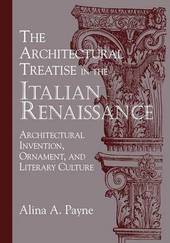
|
The Architectural Treatise in the Italian Renaissance: Architectural Invention, Ornament and Literary Culture
Paperback / softback
Main Details
| Title |
The Architectural Treatise in the Italian Renaissance: Architectural Invention, Ornament and Literary Culture
|
| Authors and Contributors |
By (author) Alina A. Payne
|
| Physical Properties |
| Format:Paperback / softback | | Pages:362 | | Dimensions(mm): Height 254,Width 178 |
|
| Category/Genre | Architecture |
|---|
| ISBN/Barcode |
9780521178235
|
| Classifications | Dewey:720.94509024 |
|---|
| Audience | | Professional & Vocational | |
|---|
| Illustrations |
Worked examples or Exercises
|
|
Publishing Details |
| Publisher |
Cambridge University Press
|
| Imprint |
Cambridge University Press
|
| Publication Date |
14 April 2011 |
| Publication Country |
United Kingdom
|
Description
Vitruvius's Ten Books of Architecture, the only architectural treatise to have survived from antiquity, was the fountainhead of architectural theory in the Italian Renaissance. Offering theoretical and practical solutions to a wide variety of architectural issues, this treatise did not, however, address all of the questions that were of concern to early modern architects. Originally published in 1999, this study examines the Italian Renaissance architect's efforts to negotiate between imitation and reinvention of classicism. Through a close reading of Vitruvius and texts written during the period 1400-1600, Alina Payne identifies ornament as the central issue around which much of this debate focused. Ornament, she argues, facilitated a dialogue across disciplines and invited exchanges with literary and rhetorical practices. Payne's study also highlights the place of the architectural treatise in the text-based culture of the period and of architectural discourse in Renaissance thought.
ReviewsReview of the hardback: 'This is an intelligent and original book that rewards close reading ... a brief summary cannot do justice to the richness of ideas in this stimulating book.' Burlington Magazine Review of the hardback: '... useful far beyond the more narrow study of Renaissance architecture... This is an important book.' The Art Book
|